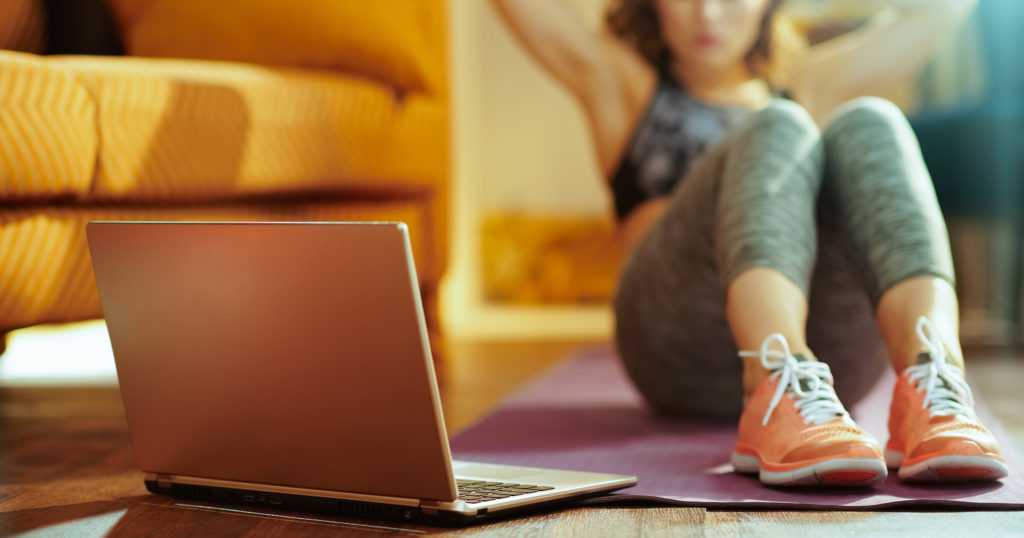Fitness Goes Home Again During COVID-19


Freelance Pilates and nutrition coach Caitlyn Cade loves her work. After teaching in studios and conducting corporate training sessions, a move to the suburbs from the city with her young family convinced her to strike out on her own and pinpoint her niche clients, which turned out to be new moms.


Cade met with clients in their homes, lugging props and accouterments from client to client.
But as COVID-19 became a pressing issue, Cade had to rethink her strategy. “I didn’t want people to be weirded out that I would come into their home, not knowing what I’ve been in contact with,” she says. Looking to keep business going while prioritizing safety, Cade notified her clients that classes would go online courtesy of Zoom videoconferencing, and advised them to buy their props online. She also discounted her rate to incentivize remote participation.
Although her client base is small, she was delighted when 90 percent of them moved over to Zoom to continue their sessions. Cade says her business will stay remote for at least “the time being.”
The fitness industry, which has traditionally depended upon recurring revenue from memberships, on-site visits, and close contact with patrons, is just one of many upended by COVID-19. Prior to shutdowns related to COVID-19, the fitness industrial complex was growing at a steady clip. The International Health Racquetball and Sportsclub Association (IHRSA) found that in 2018, 71.5 million consumers utilized a facility. Membership was at 62.5 million, and the total number of visits at nearly 40,000 facilities around topped 6 billion. Revenue in 2018 was $32.3 billion, according to the IHRSA. Statista reported the market for fitness and strength equipment in 2018 was $5.24 billion, with consumers spending $3.86 billion on equipment for at-home use.
Filling the Gap, Keeping Patrons Safe
As gyms, health clubs, boutiques, and private instructors find a safe, healthy, and profitable way forward, expect the numbers for at-home use to grow. Cade is just one of thousands of instructors and facilities utilizing modern technology to keep things running and changing the dynamics of the market. As soon as the shutdown began, fitness enthusiasts found they didn’t have to go far to continue working out and keeping fit. A robust stable of celebrities like dance legend Debbie Allen stepped up to offer viewers free or low-cost weekly classes courtesy of platforms like Instagram Live. But for fitness buffs looking for a regular routine, the industry’s offerings of apps, equipment, and smart hybrids that utilize both, became more appealing, making the home gym downright unrecognizable.
The Home Gym Gets Spa Treatment
Long gone is the rickety weight bench and the stench of sweaty socks lingering in a musty corner of some basement. Instead, if you peek into the right home gym, you’re more likely to find pricy and sophisticated gym equipment, such as high-end weights, the Peloton stationary bike or treadmill, or the Tonal workout machine. Buyers of this equipment, which also usually sells monthly memberships, get on-demand classes and workouts at their whim, in the privacy, convenience, and safety of their own homes. The Tonal workout machine, which retails for $3,000, mounts to the user’s wall and uses electromagnetism to emphasize resistance training exercises, such as bicep curls and deadlifts, and offers personalized feedback one would get from an instructor.
Peloton, one of the more established upstarts of the at-home fitness market, has experienced explosive growth due to COVID-19. In April 2020, Peloton debuted a “Live from Home” ride to a record-breaking 23,000 participants. When reporting earnings in May, Peloton said sales for the latest quarter were up 66% from a year ago, to $524.6 million, and that its subscriber base had grown 94% year over year.
Wall Street investors might not be able to get in on the ground floor at Peloton any longer, but consumer enthusiasm for other upstarts in the at-home fitness boom are sure to fill in the gap. Enter NEOU, a startup pegging itself as the “Netflix of fitness.” NEOU charges $14.99 per month or $74.99 annually and provides access to over 3,000 classes. Named as a hybrid for its mission to create a “new you,” NEOU recently announced it had raised $5 million in capital from investors, which valued the company at around $40 million. And athleisurewear company Lululemon announced in June that it was spending $500 million to buy Mirror, which offers live classes via a wall-mounted mirror as well as on-demand workouts and individual personal training sessions.
The Portable Option in A Pandemic
Anyone looking to bring fitness to the palm of their hand at a more affordable price can look no further than the bevy of apps, which remain wildly popular. IHRSA reported that in 2019, fitness app use was 51 percent, beating social media apps by two percentage points. In April, Market Resale Future projected a compound annual growth rate of 31.25 percent for fitness apps over the 2019-2026 period, thanks to accessibility on smartphones, computers, and tablets. Witness the popularity of apps such as Rock My Run, which provides a soundtrack; My Fitness Pal, which tracks fitness and nutrition; Classpass, a virtual library of various workouts; and Couch to 5k, which serves as a trainer for would-be runners looking to kick their couch potato lifestyle to the curb.
With Zoom, apps, and fancy equipment making the fitness journey easier, service providers like Cade have been able to exhale some ad feel confident about keeping clients engaged. “It feels like a real session would because we’re not just looking at each other’s space the whole time,” she says. And there’s still a market for old-school gear. Yelp reported a 344 percent increase in interest in home fitness equipment in March, and items such as good-quality dumbbells remain on backorder and waiting lists as part of the at-home fitness trend.
And while the pandemic increased interest in at-home fitness, its appeal may be enduring. Fitness enthusiast and mother of two Jennifer Lazarus was an early adopter of Peloton. Before COVID-19, she also attended classes at several studios and boutiques, including her local Orange Theory Fitness. Lazarus says she won’t be all that enthusiastic about leaving home to work out once gyms get the greenlight to reopen. “The studio is small; you’re literally on top of people,” she says. “They give you wipes, but not everyone is wiping down, and you’re constantly bumping into each other and getting close.” With home fitness becoming more sophisticated and better replicating the in-person experience, the kind of crowded classes that turned off Lazarus may be another casualty of COVID-19.

